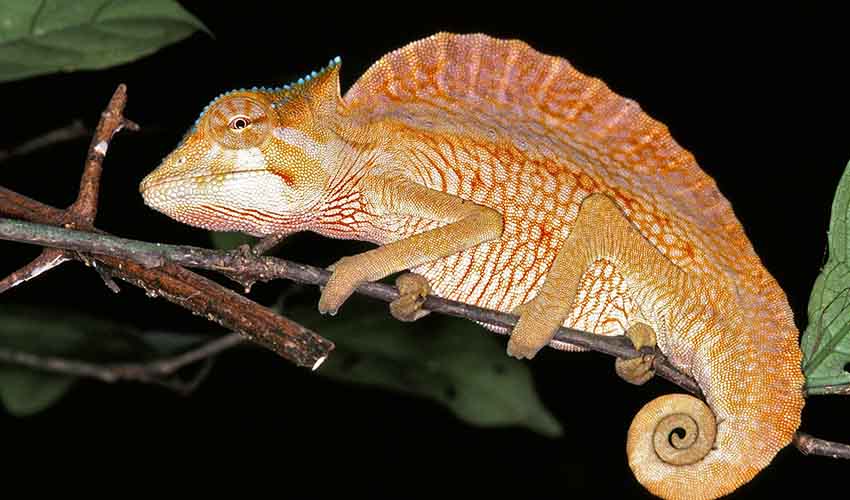As its name suggests, this species sports a tall, sail-like crest that runs along its back and tail, giving it a unique, almost prehistoric look. Combined with its triangular head and casque (helmet-like structure), the Crested chameleon looks like a miniature dinosaur making its way through the trees. Its earthy greens and browns allow it to blend seamlessly into its forest surroundings, but when it wants to signal mood or temperature changes, it can shift into brighter or darker shades.
What makes the Crested chameleon so distinct from other chameleons is that dramatic dorsal crest, which can rise several centimeters high and runs down much of its body. This feature is most pronounced in males and is often used to show dominance or impress rivals. While many chameleons rely on ornamented horns, frills, or colors to stand out, the Crested chameleon’s sail-like ridge gives it an unmistakable silhouette. Its body is also relatively large and laterally compressed, making it stand out even more when perched along a branch.
Like its relatives, the Crested chameleon is an ambush predator, relying on patience and stealth to catch prey. With its independently rotating eyes, it can scan nearly the entire environment before making a move. When an unsuspecting insect wanders close, it launches its long, sticky tongue with incredible speed and accuracy. Despite their dramatic looks, Crested chameleons are generally solitary and shy, moving slowly and carefully through the forest canopy, swaying their bodies to mimic leaves blowing in the wind.
Of course, there are plenty of fun and quirky facts about this unusual reptile. Their sail-like crest has earned them nicknames like “dragon chameleons”, and their unique shape often makes them look larger and more intimidating to potential predators. They can sleep clinging to thin branches, turning pale at night, which makes them surprisingly easy to spot with a flashlight.
Distribution
 Cameroon
Cameroon Central Af. Rep.
Central Af. Rep. Congo-Brazzaville
Congo-Brazzaville DR Congo (Kinshasa)
DR Congo (Kinshasa) Equatorial Guinea
Equatorial Guinea Gabon
Gabon Nigeria
NigeriaAnything we've missed?
Help us improve this page by suggesting edits. Glory never dies!
Suggest an editGet to know me
Terrestrial / Aquatic
Altricial / Precocial
Polygamous / Monogamous
Dimorphic (size) / Monomorphic
Active: Diurnal / Nocturnal
Social behavior: Solitary / Pack / Herd
Diet: Carnivore / Herbivore / Omnivore / Piscivorous / Insectivore
Migratory: Yes / No
Domesticated: Yes / No
Dangerous: Yes / No




